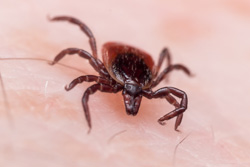The Sooner the Better: Work in Early Lyme Detection Wins LymeX Diagnostic Prize
Nearly half a million people become infected with Lyme disease in the United States each year — a number expected to grow as climate change expands the habitat of the black-legged ticks that carry the disease-causing bacteria. But despite its status as the country’s most common vector-borne disease, there is no reliable way to detect the infection in its early stages when treatment is most effective.
College of Medicine researchers have proposed a way to detect the bacterial infection by looking for a unique indicator that occurs before the immune system is able to launch a specific response. A team led by Mary Ann Comunale, EdD, MS, is a recipient of the Phase 1 LymeX Diagnostic Prize sponsored by the U.S. Department of Health and Human Services and the Steve & Alexandra Cohen Foundation. The prize competition was created to accelerate the development of a new Lyme disease diagnostic toward FDA approval. Comunale’s submission was selected from 52 entries. The competition was judged by a panel of experts in vector-borne disease biology, technology transfer, and patient experience and advocacy. Comunale is now eligible to compete in Phase 2 of the accelerator.
The challenge of detecting Lyme disease lies in the evasiveness of the Borrelia burgdorferi bacteria. The bacteria quickly leave the bloodstream and move into surrounding tissue, becoming virtually undetectable. As a result, diagnosis relies on a specific immune response toward the bacteria; this response doesn’t show up until weeks into the infection. Even then, current tests miss the infection about half the time. As a further complication, people can become reinfected, but diagnostic tests will not work on subsequent infections because there is no way to know if an immune response is from the first infection or a new one.

Members of the research team Jintong Hou, a Biostatistics PhD student, Mary Ann Comunale, EdD, MS, assistant professor of microbiology and immunology, and Benjamin Haslund-Gourley, a Microbiology & Immunology PhD student in the MD/PhD program.
“Antibiotic treatment in the early stage of Lyme disease is necessary. Without it, the disease can quickly progress and cause irreversible damage to the body,” says Comunale, an assistant professor of microbiology and immunology. “But in many cases, the patient is not aware they have been bitten by a tick or does not display the tell-tale bull’s-eye rash. Since Lyme symptoms are nonspecific, and tests perform so poorly in the early stages, patients often go undiagnosed beyond the window during which antibiotics would be most effective.”
The researchers have taken a unique approach to tracking B. burgdorferi, one that looks closely at carbohydrate molecules called glycans. Glycans are found on many serum proteins, including those that play an important role in the immune response. During disease, these glycans often change, and this change plays a role in the protein’s function. When it comes to proteins involved in the immune response, the glycans can make the proteins either more or less efficient at clearing the infection.
This altered response is key to the team’s approach to early detection of Lyme disease. “Because the glycan pattern is different from what is seen in other diseases that have clinical symptoms similar to Lyme, we can use it as a reliable biomarker,” Comunale says. “Importantly, we see these differences early, when current tests would produce false negative results. We also see the same changes in reinfections, so we can differentiate a new infection from an old one.”

According to Comunale, results from early phases of testing indicate that her method could be more than 80% sensitive at detecting a Lyme infection in its early stages. This is a tremendous improvement over the current FDAcleared tests, which are only about 48% accurate during early acute Lyme disease. Her team is building on the early results and using machine learning to develop the final test algorithm. Comunale acknowledges the hard work of the Bay Area Lyme Disease Foundation Biobank and all the patients who donated blood to support research. She emphasizes that “without their donations, this work would not be possible.”
Comunale has worked in glycobiology and diagnostics for over two decades. She holds four patents in liver pathology and is a co-inventor of a glycobiology-based diagnostic for the detection of early-stage liver cancer. The initial Lyme disease work was supported by an award from the Mary DeWitt Pettit, MD Fellowship, and follow-up funding from the Drexel-Coulter Translational Research Partnership Program. The team includes two PhD students, Benjamin Haslund-Gourley (Microbiology & Immunology), and Jintong Hou (Biostatistics); Joris Beld, PhD, assistant professor of microbiology and immunology, College of Medicine; Kevin Owens, PhD, associate professor of chemistry, College of Arts and Sciences; Anand Mehta, DPhil, professor of cell and molecular pharmacology, the Medical University of South Carolina; and George Dempsey, MD, medical director, East Hampton Family Medicine in East Hampton, New York.
Back to Top